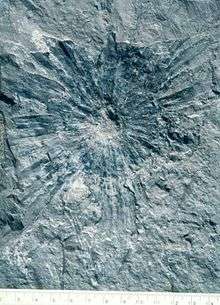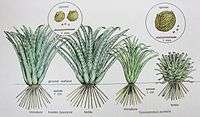Isoetes beestonii
Isoetes beestonii is the oldest known species of the living quillwort genus from the latest Permian of New South Wales and Queensland. Originally considered earliest Triassic,[1] it is now known to be latest Permian in age, immediately before the Permian Triassic mass extinction.[2]
| Isoetes beestonii | |
|---|---|
 | |
| Complete plant of Isoetes beestonii from latest Permian Coalcliff Sandstone in South Bulli Colliery, NSW, Australia.[1] | |
| Scientific classification | |
| Kingdom: | Plantae |
| Clade: | Tracheophytes |
| Clade: | Lycophytes |
| Class: | Lycopodiopsida |
| Order: | Isoetales |
| Family: | Isoetaceae |
| Genus: | Isoetes |
| Species: | †I. beestonii |
| Binomial name | |
| †Isoetes beestonii Retallack | |
Description
Isoetes beestonii is preserved as whole plants in life position within bedding planes, and presumably lived as an early successional weed in lake and pond sedimentary environments, like living Isoetes. Its leaves were wider and more succulent than modern species of Isoetes.[1] Like modern Isoetes, fertile plants were little different from sterile plants, unlike Early Triassic Tomiostrobus which formed woody conelike fertile plants.

Reconstructions of sterile and fertile examples of Isoetes beestonii from the latest Permian Coal Cliff Sandstone of South Bulli Colliery, NSW, and of Tomiostrobus australis from the Early Triassic Gosford Formation near Terrigal, NSW
gollark: Does it actually say, or even strongly imply, "children need two opposite-gender parents"?
gollark: Does Christianity actually *say* that anywhere?
gollark: The role of mother/father probably varies more across cultures than across genders in modern culture.
gollark: Technology is great! We live longer, have more stuff to do, sort of thing.
gollark: What, seriously?
See also
- Evolution of plants
References
- Retallack, Gregory J. (1997). "Earliest Triassic origin of Isoetes and quillwort evolutionary radiation". Journal of Paleontology. 7 (3): 500–521.
- Retallack, Gregory J. (2013). "Permian and Triassic greenhouse crises". Gondwana Research. 24: 90–103. doi:10.1016/j.gr.2012.03.003.
This article is issued from Wikipedia. The text is licensed under Creative Commons - Attribution - Sharealike. Additional terms may apply for the media files.